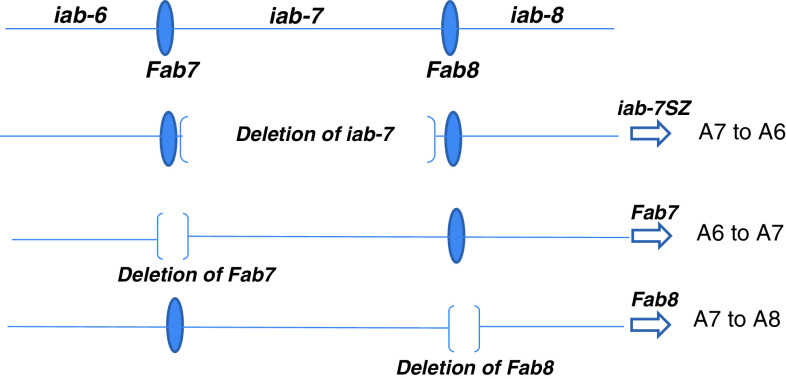Fig. 4.
Genetic and molecular nature of deletions within regulatory elements of the BX-C. The iab-6, iab-7 and iab-8 cis-regulatory elements drive the expression of Abd-B gene in increasing levels in PS11, PS12 and PS13, respectively, which give rise to the abdominal segments A6 to A8. The iab-6, iab-7 and iab-8 cis-regulatory elements are separated by the Fab7 and Fab8 insulator elements. The function of these insulators and enhancers has been deciphered by genetic ablations of these regions resulting in homeotic phenotypes. The deletions that remove the iab-7 element (iab-7SZ) lead to the transformation of A7 to A6 as iab-6 takes over the function of the deleted iab-7 in the A7 region, giving rise to the loss of the function anteriorization phenotype. This happens because in PS12/A7 all the regulatory elements from iab-2 to iab-7 are in an open conformation state, but since iab-7 is proximal to the Abd-B gene it prevails in driving it in the PS12/A7 region. In case of the iab-7 deletion, the last regulatory module to be in an open chromatin state is iab-6 in PS12/A7; hence it takes over the iab-7 function and leads to A7 to A6 transformation. In case of the deletion of the boundary element Fab7, the iab-6 and iab-7 domains fuse to form a hybrid element where iab-7 prevails and is ectopically activated within the iab-6 domain (PS11/A6), thus leading to A6 to A7 dominant gain of function transformation. A similar posteriorization phenotype is observed in the case of Fab8 deletion where the iab-7 and iab-8 domains are fused, leading to ectopic activation of iab-8 in the iab-7 domain (A7), thus leading to A7 to A8 transformation

